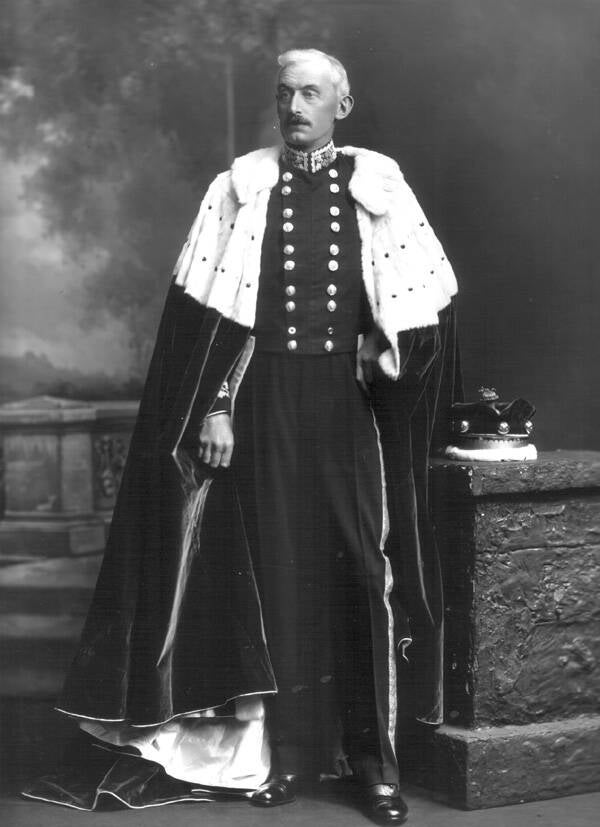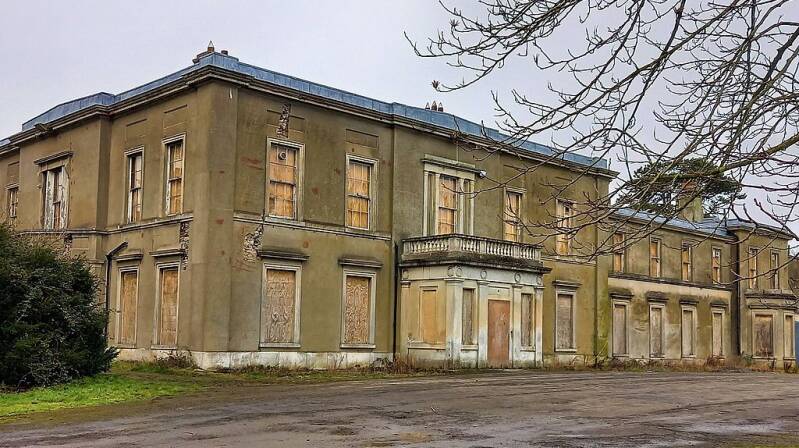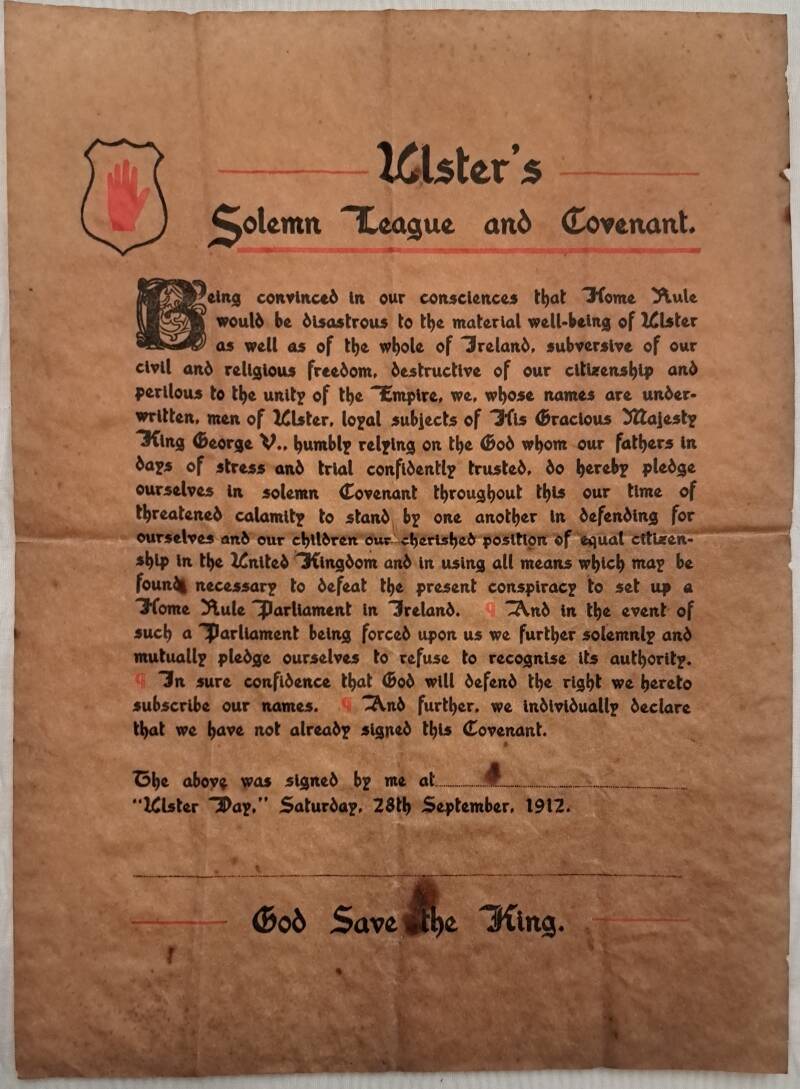The Early Years
Birth Certificate & 1901 Census

John was born on 22 September, 1891 in Ballywalter, County Down. His name was recorded in the 1901 UK census taken on the 31st March when he was nine years old. He lived with his parents, William John and Jane, along with his three brothers and two sisters at House 28 in Ballywalter, County Down. A lodger, John Roddy, a lightship man from County Louth, lived with the family.
Another Eccles family lived in House 82 where Alexander, possibly William John's older brother - John's uncle - lived.
***

The original census form

Lord Dunleath, Ballywalter Park
The next time we meet John is ten years later on Sunday, 2 April, 1911 when the last ever all-Ireland census was taken.
John was by then nineteen years old and was living and working on the huge 13,500-acre Ballywalter Park estate owned by Lord and Lady Dunleath. He was a gardener and domestic servant.

Front entrance to Ballywalter Park (Springvale)



Coat of Arms
Semper Proe Cinctus - Always surrounded by advantage
Ballywalter Park, originally named Springvale, has been the home of the Mulholland family since 1846. The family is possibly a branch of the ancient sept of MacLellan of Argyllshire. They first established in County Antrim around the early 1700's before spreading to other Irish counties.
The first record of the family name in Antrim was that of Martha Mulholland, dated 13th June, 1711 during the reign of Queen Anne.
John worked at Ballywalter Park during the time of the 2nd Baron, Henry Lyle, who was also the High Sheriff of County Down, a Major in the Royal Irish Rifles and a member of parliament. The baron was referred to as Lord Dunleath.

Henry Lyle Mulholland, 2nd Baron Dunleath (1854 – 1931)

Ballywalter Park, 2021
When John left employment at Ballywalter Park to seek other work, Lord Dunleath's head gardener, W King, gave him a glowing reference.


The Station - Newtownards
Telegrams - Ballywalter
The Gardens
Ballywalter Park
County Down
6 Jany '12
This is to certify that John Eccles was employed in these Gardens for the past 8 years* and for the latter part a journeyman under glass during which time I have always found him sober, honest, willing & most obliging. He is very attentive to his duties, in which he takes a very great interest, his whole ambition being to rise in the profession.
He has a first class knowledge of his work perhaps more so under glass including house and table decorations.
He is all (?) of smart appearance, I can honestly recommend him with the greatest confidence in the knowledge that he will give satisfaction to whomsoever employs him.
I may state that he leaves this at his own request with the object of gaining experience.
W King
Gardener for
Lord Dunleath
-----------------------------------------
* This means that John began work at Ballywalter Park when he was only twelve years old!

Garden team at Ballywalter Park, 1910
Viscount Iveagh and Lady Holmpatrick, Co. Dublin
After leaving the service of Lord Dunleath, John travelled to Co. Dublin to work for Edward Guinness, the Viscount Iveagh at Farmleigh in Castleknock, Co. Dublin. He worked there for two years. The reference provided by Lord Iveagh's steward states, "I always found [John] a most honest, steady, and obliging young man, with a desire to do his duty, and a good fruit and plant grower.
After that, John worked for seven months in The Gardens at Abbotstown House, Castleknock for Lady Holmpatrick. The gardener, JP Sharp, said in his reference that John, "...served as inside foreman. I have always found him thoroughly reliable and of excellent character. He has had charge here of a large quantity of fruit and plant houses, and in all departments has shown great ability and a wide knowledge of his business."

Farmleigh and the Guinness family
Farmleigh was built in the mid-1700s. It is situated above the River Liffey, northwest of Phoenix Park. The estate has 78 acres and consists of extensive private gardens with cypress, pine and oak trees, a pond, and walled and sunken gardens.
It was purchased by the Guinness family in 1873. Edward Guinness was created Baron Iveagh in 1891 and Earl Iveagh in 1919.
In 1999, the Irish government purchased Farmleigh from the 4th Earl of Iveagh for over €29 million. It is now the official Irish state guest house and has hosted various heads of state and dignitaries including Queen Elizabeth II and numerous prime ministers.
More on Farmleigh


Abbotstown House and the Barons HolmPatrick
The Falkiner family became Baronets of Abbotstown in 1812. The Hamilton family (originally from Hamiltonsbawn, County Armagh) owned the neighbouring estate of Sheephill, and in 1832, the two estates were amalgamated through marriage and a new residence, Abbotstown House, was built.
During the time that John Eccles was working at Abbotstown, Hans Hamilton, 2nd Baron HolmPatrick was serving in the British army as adjutant for the 16th Lancers (1912-14), so, in his absence, his widowed mother was responsible for the 3,647-acre demense. The property was taken over by the government in 2005 and is currently derelict.
More info: 'Lord Belmont' blog,


The Ulster Covenant
In 1912, opposition in the north-eastern counties of Ireland to the Home Rule Bill making its way through parliament at Westminster was clearly expressed when over half a million men and women signed the Solemn League and Covenant.
In 1913, the Irish unionists, who had been drilling with wooden guns, came together in a single body to form the Ulster Volunteer Force (UVF), and by the spring of 1914, the organisation had landed approximately 25,000 guns.
James Craig, a leader within Unionism and future prime minister, transferred the headquarters of the expanding UVF from the centre of Belfast to his home, Craigavon House, on the eastern edge of the city.

Craigavon House, Strandtown, Belfast
A 'John Eccles' signed the Ulster Covenant in the Dunleath Arms Hotel in Ballywalter on 28th September, 1912, but that may have been his father, William John Eccles. The photo below is of an actual covenant that my grandfather kept in his private papers.
We will revisit Craigavon House later in John's story.


Dunleath Arms Hotel, Ballywalter
Heading to War
We have no record of where John was between October, 1914 - when he left Abbotstown, Dublin - and the following spring, but war had broken out with Germany and the next time we see him, he is in north Belfast, and he has just signed up with the Army Cyclist Corps to fight the Hun. It's Easter Monday, 5th April, 1915.
In the Great War he is about to enter into a very different life to the one that has, to this point, only seen him surrounded by fruit and vegetables on peaceful country estates.


Create Your Own Website With Webador